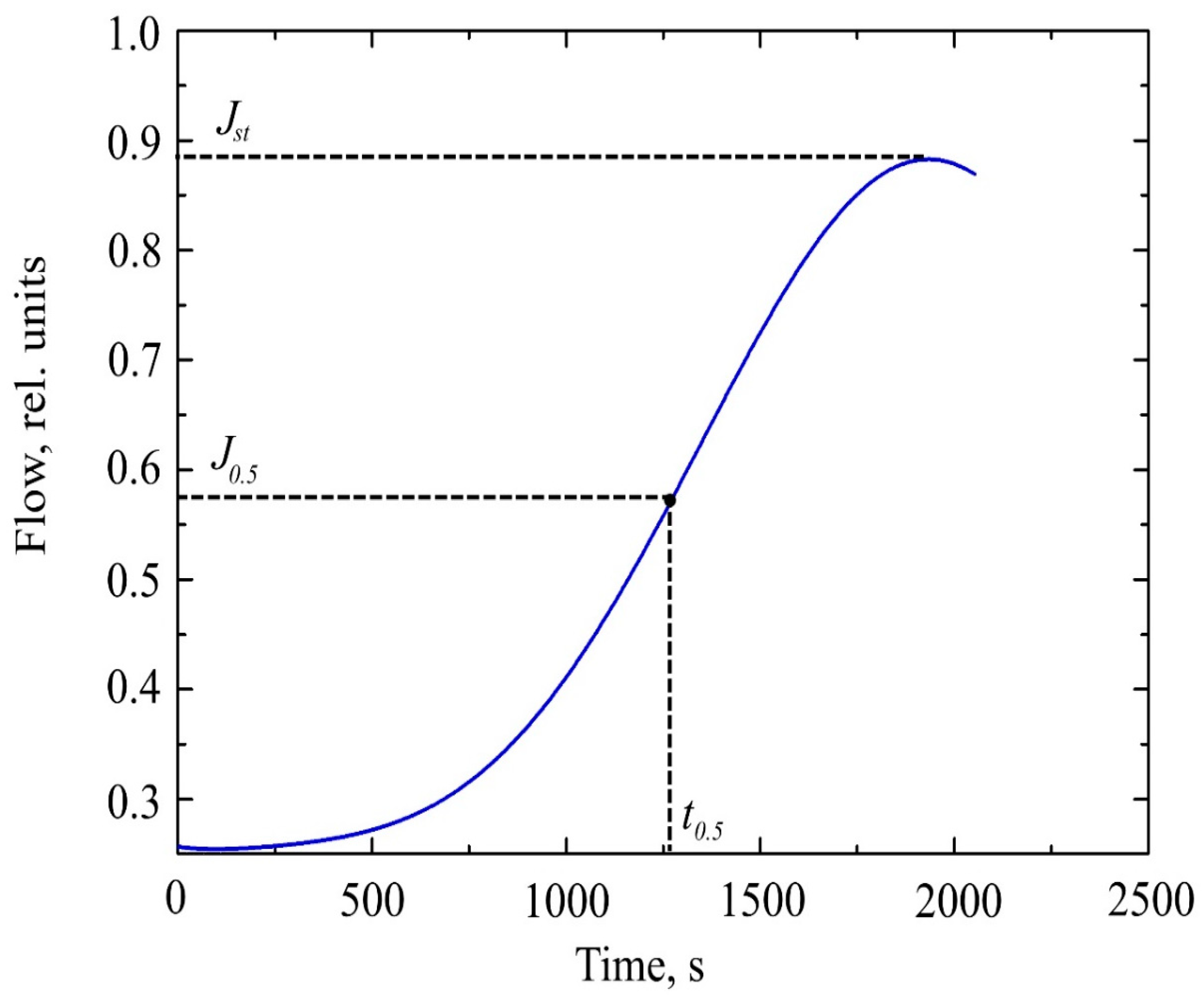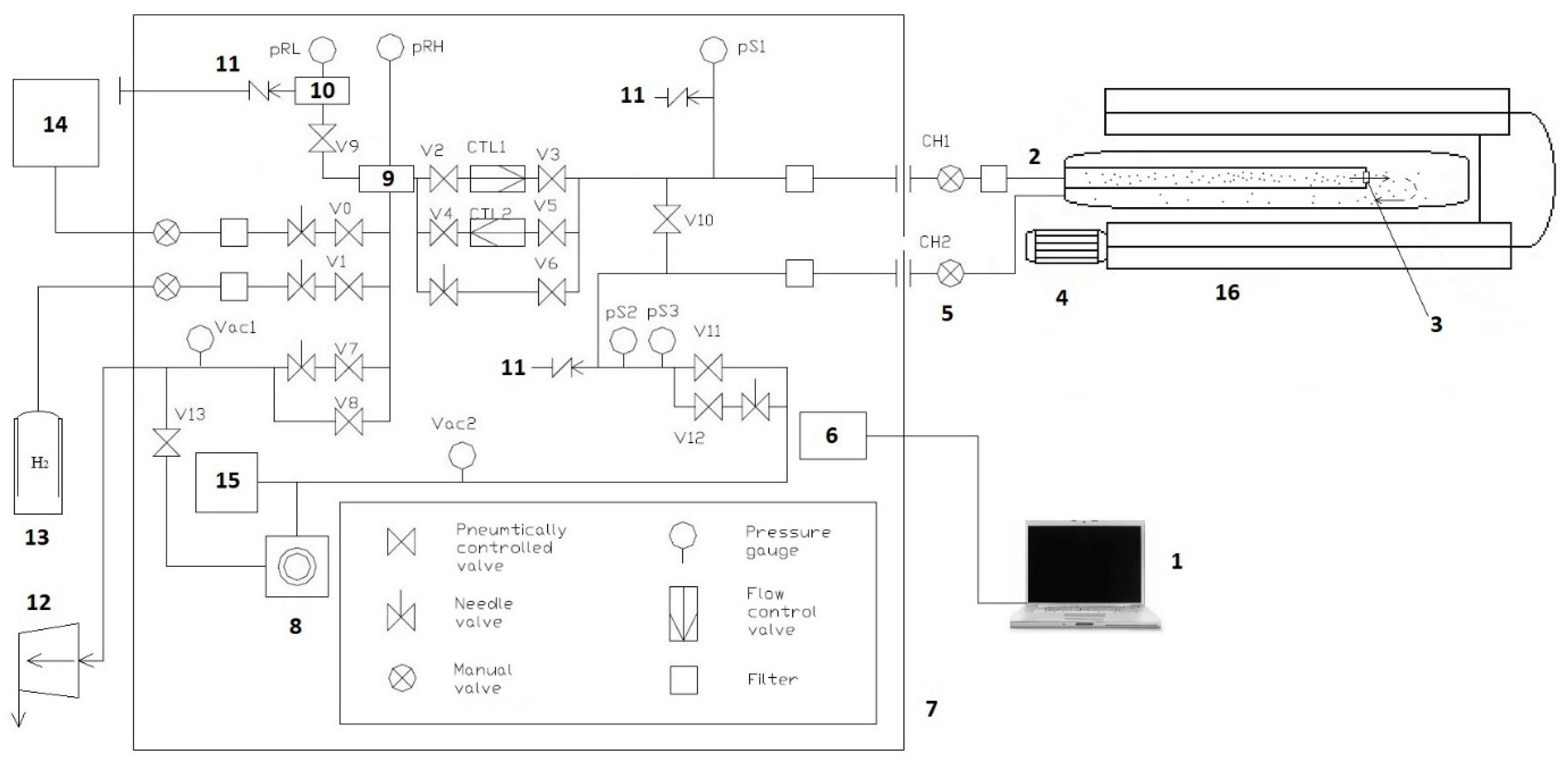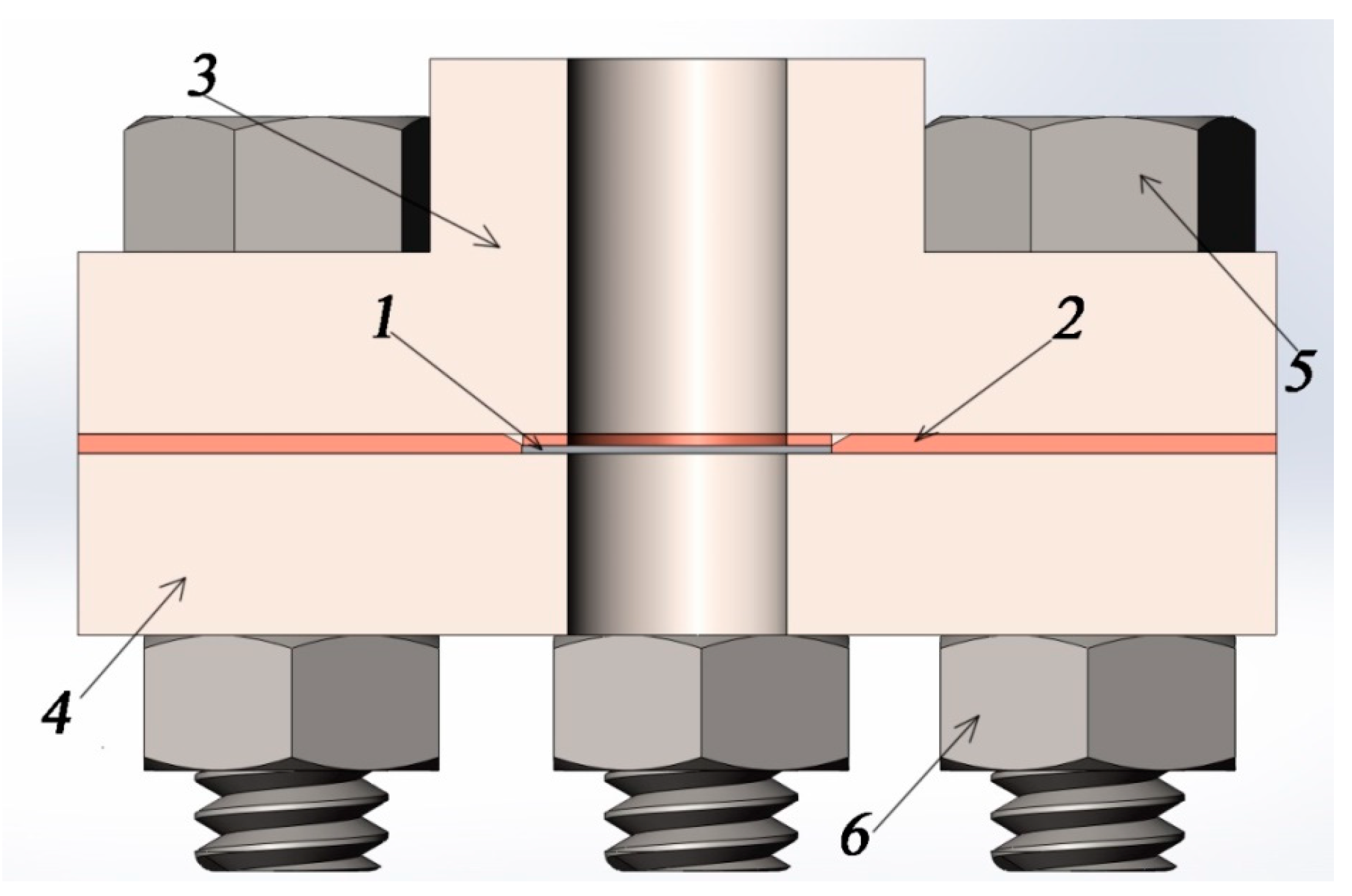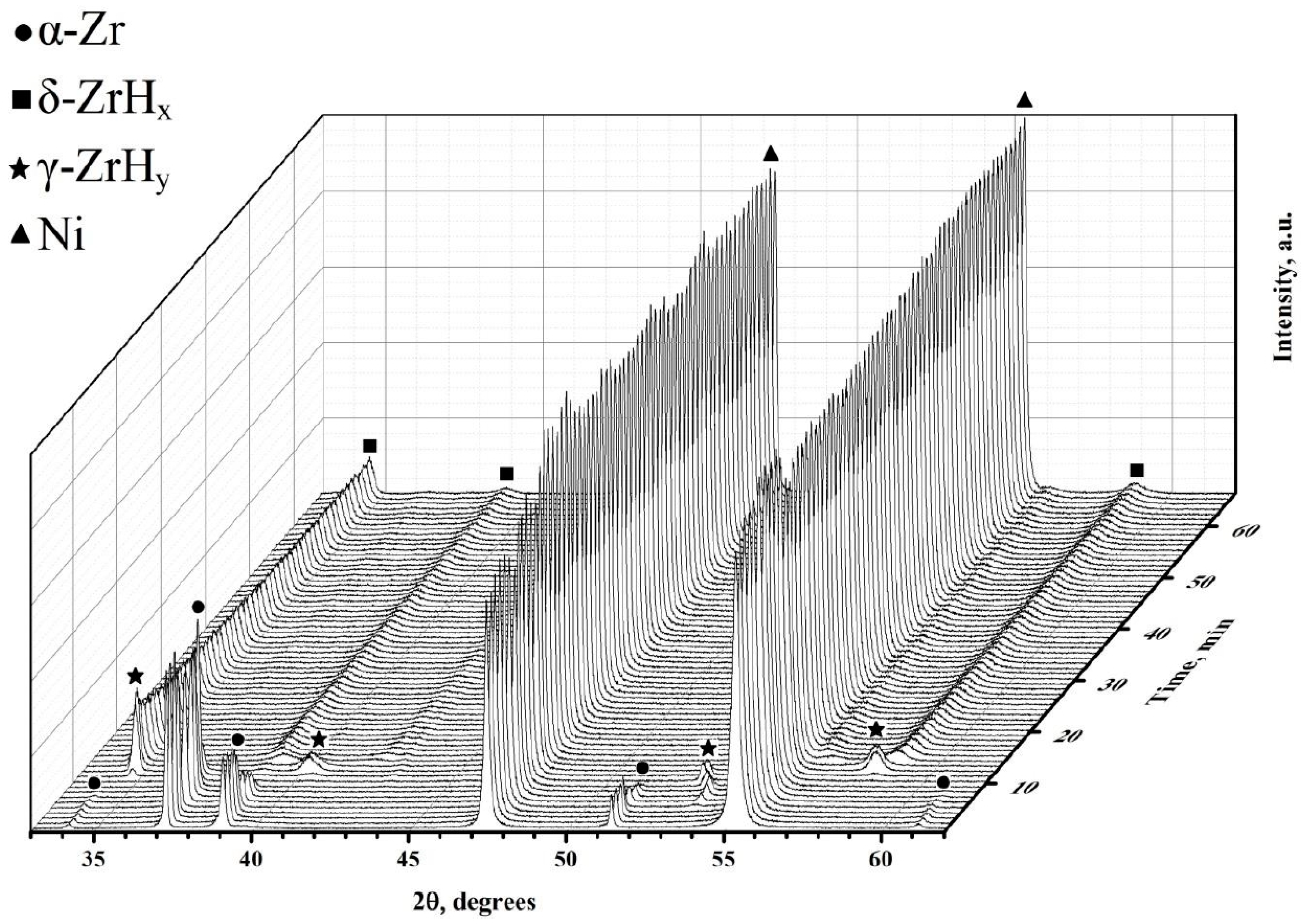Development of Experimental Chamber for Testing High-Temperature Hydrogen Permeation through Metal Foils
Abstract
:1. Introduction
2. Materials and Research Methods
3. Results and Discussion
4. Summary
Author Contributions
Funding
Acknowledgments
Conflicts of Interest
References
- Besenbacher, F.; Myers, S.M.; Nørskov, J.K. Interaction of hydrogen with defects in metals. Nucl. Instrum. Methods Phys. Res. Sect. B 1985, 7, 55–66. [Google Scholar] [CrossRef]
- Wu, C.; Wang, Q.; Mao, Y.; Huang, L.; Chen, Y.; Dai, X. Relationship between lattice defects and phase transformation in hydrogenation/dehydrogenation process of the V60Ti25Cr3Fe12 alloy. Int. J. Hydrogen Energy 2019, 44, 9368–9377. [Google Scholar] [CrossRef]
- Nørskov, J.K.; Besenbacher, F. Theory of hydrogen interaction with metals . J. Less Common Met. 1987, 130, 475–490. [Google Scholar] [CrossRef]
- Christmann, K. Interaction of hydrogen with solid surfaces. Surf. Sci. Rep. 1988, 9, 1–163. [Google Scholar] [CrossRef]
- Kudiiarov, V.N.; Syrtanov, M.S.; Bordulev, Y.S.; Babikhina, M.N.; Lider, A.M.; Gubin, V.E.; Murashkina, T.L. The hydrogen sorption and desorption behavior in spherical powder of pure titanium used for additive manufacturing. Int. J. Hydrogen Energy 2017, 42, 15283–15289. [Google Scholar] [CrossRef]
- Tarasov, B.P.; Arbuzov, A.A.; Mozhzhuhin, S.A.; Volodin, A.A.; Fursikov, P.V.; Lototskyy, M.V.; Yartys, V.A. Hydrogen storage behavior of magnesium catalyzed by nickel-graphene nanocomposites. Int. J. Hydrogen Energy 2019, 44, 29212–29223. [Google Scholar] [CrossRef]
- Ren, J.; Musyoka, N.M.; Langmi, H.W.; Mathe, M.; Liao, S. Current research trends and perspectives on materials-based hydrogen storage solutions: A critical review. Int. J. Hydrogen Energy 2017, 42, 289–311. [Google Scholar] [CrossRef]
- Louthan, M.R.; Caskey, G.R.; Donovan, J.A.; Rawl, D.E. Hydrogen embrittlement of metals. Mater. Sci. Eng. 1972, 10, 357–368. [Google Scholar] [CrossRef]
- Rogne, B.R.S.; Kheradmand, N.; Deng, Y.; Barnoush, A. In situ micromechanical testing in environmental scanning electron microscope: A new insight into hydrogen-assisted cracking. Acta Mater. 2018, 144, 257–268. [Google Scholar] [CrossRef]
- Teichmann, N.; Hamm, M.; Pundt, A. Fast lateral hydrogen diffusion in magnesium-hydride films on sapphire substrates studied by electrochemical hydrogenography. Int. J. Hydrogen Energy 2018, 43, 1634–1642. [Google Scholar] [CrossRef]
- Zieliński, A.; Sobieszczyk, S. Hydrogen-enhanced degradation and oxide effects in zirconium alloys for nuclear applications. Int. J. Hydrogen Energy 2011, 36, 8619–8629. [Google Scholar] [CrossRef]
- Tong, L.S.; Weisman, J. Thermal Analysis of PRESSURIZED Water Reactors; American Nuclear Society: La Grange Park, IL, USA, 1979. [Google Scholar]
- Neeb, K.H. The Radiochemistry of Nuclear Power Plants with Light Water Reactors; Walter de Gruyter: Berlin, Germany, 2011. [Google Scholar]
- Woodtli, J.; Kieselbach, R. Damage due to hydrogen embrittlement and stress corrosion cracking. Eng. Fail. Anal. 2000, 7, 427–450. [Google Scholar] [CrossRef]
- Nagase, F. Hydride behavior in Zircaloy cladding tube during high-temperature transients. J. Nucl. Mater. 2011, 415, 117–122. [Google Scholar] [CrossRef]
- Daum, R.S.; Bates, D.W.; Koss, D.A.; Motta, A.T. The influence of a hydride layer on the fracture of zircaloy-4 cladding tubes. In Proceedings of the International Conference on Hydrogen Effects on Material Behaviour and Corrosion Deformation Interactions, Moran, WY, USA, 22–26 September 2002. [Google Scholar]
- Motta, A.T.; Chen, L.Q. Hydride formation in zirconium alloys. J. Miner. Met. Mater. Soc. 2012, 64, 1403–1408. [Google Scholar] [CrossRef]
- Nagase, F.; Fuketa, T. Investigation of hydride rim effect on failure of Zircaloy-4 cladding with tube burst test J. Nucl. Sci. Technol. 2005, 42, 58–65. [Google Scholar] [CrossRef]
- Hanson, B.; Shimskey, R.; Lavender, C.; MacFarlan, P.; Eslinger, P. Hydride Rim Formation in Unirradiated Zircaloy; Pacific Northwest National Laboratory: Richland, WA, USA, 30 April 2013. [Google Scholar]
- Shimskey, R.W.; Hanson, B.D.; MacFarlan, P.J. Optimization of Hydride Rim Formation in Unirradiated Zr 4 Cladding; Pacific Northwest National Laboratory: Richland, WA, USA, 30 September 2013. [Google Scholar]
- Chernov, I.P.; Cherdantsev, Y.P.; Lider, A.M.; Tyurin, Y.I.; Pushilina, N.S.; Ivanova, S.V. Hydrogen permeability of protective coating formed by electron treatment of zirconium alloys. J.Surf. Investig. X-ray Synchrotron Neutron Tech. 2010, 4, 255–261. [Google Scholar] [CrossRef]
- Alefeld, G.; Völkl, J. Hydrogen in Metals I-Basic Properties; Springer: Berlin, Germany, 1978. [Google Scholar]
- Warr, B.D.; Elmoselhi, M.B.; Newcomb, S.B.; McIntyre, N.S.; Brennenstuhl, A.M.; Lichtenberger, P.C. Oxide characteristics and their relationship to hydrogen uptake in zirconium alloys. In Zirconium in the Nuclear Industry, Proceedings of the Ninth International Symposium, Kobe, Japan, 5–8 November 1990; ASTM International: West Conshohocken, PA, USA, 1991. [Google Scholar]
- Kudiiarov, V.N.; Kashkarov, E.B.; Syrtanov, M.S.; Lider, A.M. Hydrogen sorption by Ni-coated titanium alloy VT1-0. Int. J. Hydrogen Energy. 2017, 42, 10604–10610. [Google Scholar] [CrossRef]
- Olden, V.; Alvaro, A.; Akselsen, O.M. Hydrogen diffusion and hydrogen influenced critical stress intensity in an API X70 pipeline steel welded joint–Experiments and FE simulations. Int. J. Hydrogen Energy 2012, 37, 11474–11486. [Google Scholar] [CrossRef]
- Mohtadi-Bonab, M.A.; Szpunar, J.A.; Collins, L.; Stankievech, R. Evaluation of hydrogen induced cracking behavior of API X70 pipeline steel at different heat treatments. Int. J. Hydrogen Energy 2014, 39, 6076–6088. [Google Scholar] [CrossRef]
- Zhao, W.; Zhang, T.; He, Z.; Sun, J.; Wang, Y. Determination of the critical plastic strain-induced stress of X80 steel through an electrochemical hydrogen permeation method. Electrochim. Acta 2016, 214, 336–344. [Google Scholar] [CrossRef]
- El Alami, H.; Creus, J.; Feaugas, X. Influence of the plastic strain on the hydrogen evolution reaction on polycrystalline nickel electrodes in H2S04. Electrochim. Acta 2006, 51, 4716–4727. [Google Scholar] [CrossRef]
- Nikitenkov, N.N.; Hashhash, A.M.; Shulepov, I.A.; Khoruzhii, V.D.; Tyurin, Y.I.; Chernov, I.P.; Kudryavtseva, E.N. A plant for studying radiation and thermal desorption of gases from inorganic materials. Instrum. Exp. Tech. 2009, 52, 865. [Google Scholar] [CrossRef]
- Nayebossadri, S.; Speight, J.D.; Book, D. Hydrogen separation from blended natural gas and hydrogen by Pd-based membranes. Int. J. Hydrogen Energy 2019, 44, 29092–29099. [Google Scholar] [CrossRef]
- Deveau, N.D.; Yen, P.S.; Datta, R. Evaluation of hydrogen sorption and permeation parameters in liquid metal membranes via Sieverts’ apparatus. Int. J. Hydrogen Energy 2018, 43, 19075–19090. [Google Scholar] [CrossRef]
- Mueller, W.M.; Blackledge, J.P.; Libowitz, G.G. Metal Hydrides; Academic Press: New York, NY, USA, 1968. [Google Scholar]
- Poirier, D.R.; Geiger, G.H. Fick’s Law and Diffusivity of Materials In Transport Phenomena in Materials Processing; Springer: Berlin, Germany, 2016; pp. 419–461. [Google Scholar]
- Barasheva, T.V.; Anisimova, I.A.; Guskova, E.I.; Ermolova, M.I. Hydrogen diffusion in titanium and zirconium alloys. Metall. Heat Treat. Metals 1978, 4, 75–78. [Google Scholar]
- Moran, M.J.; Shapiro, H.N.; Boettner, D.D.; Bailey, M.B. Fundamentals of Engineering Thermodynamics; Wiley: Hoboken, NJ, USA, 2010. [Google Scholar]
- Syrtanov, M.S.; Kudiiarov, V.N.; Kashkarov, E.B.; Shmakov, A.N.; Vinokurov, Z.S.; Babikhina, M.N.; Zolotarev, K.V. Application of synchrotron radiation for In Situ XRD investigation of zirconium hydrides formation at gas-phase hydrogenation. Phys. Procedia 2016, 84, 342–348. [Google Scholar] [CrossRef]
- Chernyaeva, T.P.; Ostapov, A.V. Hydrogen in zirconium part 2. State and dynamics of hydrogen in zirconium. Issues Atomic Sci. Technol. 2014, 2, 3–16. [Google Scholar]







| Experimental Technique | Time of Existence, min. | ||
|---|---|---|---|
| α-phase | γ-phase | δ-phase | |
| High-temperature permeability | 10 | 3 | - |
| X-ray diffraction during hydrogenation | 10 | 5 | - |
| Parameter | α-phase | δ-phase |
|---|---|---|
| The time to establish half of the stationary flow, sec | 505 | 3870 |
| Maximum value error | 4.107 × 10−4 | 0.0103 |
| Z value | 10−3 | 3.98 × 10−3 |
| Diffusion coefficient, cm2/s | 5 × 10−5 | 1.6 × 10−6 |
| Literature data of diffusion coefficient, cm2/s | 2.5 × 10−5 [37] | 1.8 × 10−7 [37] |
© 2019 by the authors. Licensee MDPI, Basel, Switzerland. This article is an open access article distributed under the terms and conditions of the Creative Commons Attribution (CC BY) license (http://creativecommons.org/licenses/by/4.0/).
Share and Cite
Kudiiarov, V.; Sakvin, I.; Garanin, G.; Lider, A. Development of Experimental Chamber for Testing High-Temperature Hydrogen Permeation through Metal Foils. Metals 2019, 9, 1314. https://doi.org/10.3390/met9121314
Kudiiarov V, Sakvin I, Garanin G, Lider A. Development of Experimental Chamber for Testing High-Temperature Hydrogen Permeation through Metal Foils. Metals. 2019; 9(12):1314. https://doi.org/10.3390/met9121314
Chicago/Turabian StyleKudiiarov, Viktor, Ivan Sakvin, Georgy Garanin, and Andrey Lider. 2019. "Development of Experimental Chamber for Testing High-Temperature Hydrogen Permeation through Metal Foils" Metals 9, no. 12: 1314. https://doi.org/10.3390/met9121314





